For a few dollars, you can make $40,000 worth (100 million propagules) of mycorrhizal fungi inoculant by doing it yourself. No scientific equipment needed.
Read on to learn about mycorrhizal fungi or skip to the instructions
What is Mycorrhizal Fungi?
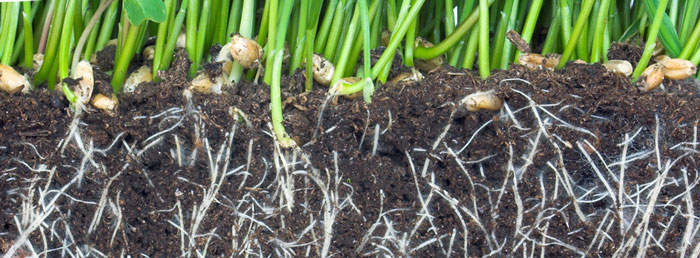
Short answer: Mycorrhizal fungi is a naturally occurring beneficial soil organism that forms a symbiotic relationship with plant roots.
For the past 460 million years, an estimated 80–90% of the earth’s land plants have existed with mycorrhizae naturally, in various climates from deserts to wet rainforests.
Terminology:
- Mycorrhizae (plural); Mycorrhiza (singular): defines the association between plant and fungus
- Mycorrhizal fungi: refers to the fungi itself
The name mycorrhizae (Myco meaning fungi and rhizae meaning roots) is a term for symbiotic associations between plant roots and fungi. This mutualistic growth is, in most cases, beneficial to both the host plant and the fungi.
Mycorrhizal fungi are the fungi that colonize plant roots. To survive, the fungi get carbohydrates and other compounds excreted from living plant roots. In exchange, the fungi assist plants in ways such as increasing nutrient and water uptake, especially the mineral nutrient phosphorus.
Plants with mycorrhizae often grow bigger and faster due to this increased nutrient uptake.
Types of Mycorrhizal Fungi
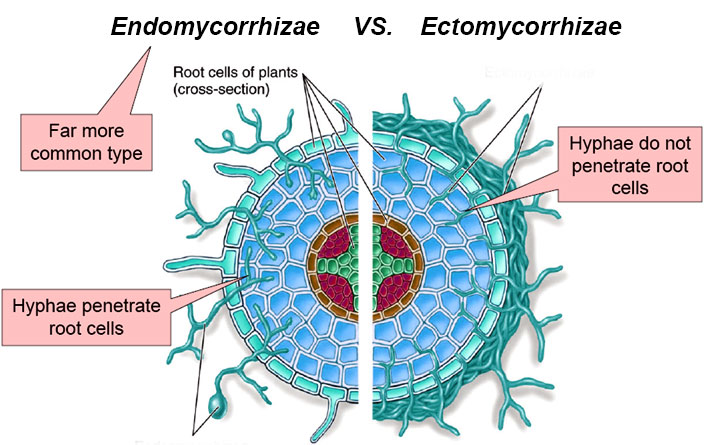
Mycorrhizae are classified as ectomycorrhizae and endomycorrhizae.
- Endomycorrhizae penetrate cells of the plant root
- Ectomycorrhiazae do not penetrate the cells of the plant root
“Why do I need to know the difference?”
Coniferous trees, oak, beech, birch, chestnut, and hickory trees only associate with ectomycorrhizae.
Most vegetables, crops, shrubs, trees, grass, and cannabis only associate with endomycorrhizae.
- Endomycorrhizae have been further classified as arbuscular, ericoid, arbutoid, monotropoid, and orchid mycorrhizae.
Arbuscular Mycorrhizae:
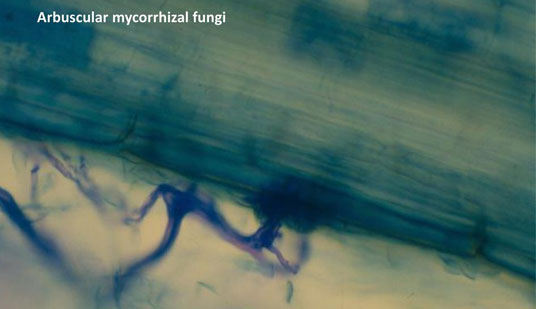
The most common type of endomycorrhizae is known as Arbuscular Mycorrhizae (AM fungi, AMF, VAM). AM fungi are found in 80% of vascular plants and are considered the #1 most abundant symbionts in ecosystems around the world. The earliest fossils of plant roots contain Arbuscular Mycorrhiza nearly identical to the kind found in today’s soils. [1]
- Arbuscular is a term to describe the tree-like structure of the fungi, forming a visible mycelium of branching white filaments, as shown below.
- Over 150 AM fungal species have been described so far.
- Rhizophagus irregularis (previously known as Glomus intraradices) are the most prolific species of AM fungi known to facilitate nutrient uptake in plants.
What’s so good about it?
AM fungi have been shown to increase the growth and nutritive status of nearly every annual (or biennial) agronomic crop (excluding the Brassica family of vegetables). [2]
During this intracellular symbiosis, AM fungi colonize a plant’s roots, increasing its rhizosphere. This symbiosis enhances water and nutrient uptake to host plants while protecting roots from soil-borne pathogens. [2]
AM fungi release immobilized nutrients such as phosphorus, sulfur, nitrogen, and micronutrients from material sources in the soil to be passed onto the host plant.[3]
Key Points:
AM fungi (arbuscular mycorrhizal fungi) can be found naturally in soils around the world. Studies have shown the importance mycorrhizal fungi have in providing plants nutrients required to grow.
Arbuscular Mycorrhizal Fungi Inoculant
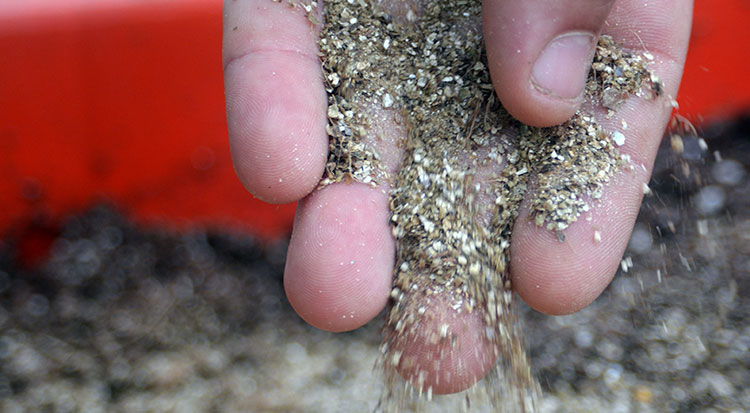
AM fungi can reproduce through spores, hyphae, and colonized root pieces. These are all used as inoculum.
What to know:
- Propagule is a word that defines spores, mycelium, and root pieces—all viable means of mycorrhizal infection.
- Spores are made within the root cortex or on the hyphae. These large (20–1000+ μm) asexual spores have a long shelf life and are resilient to high and low temperatures, moisture, drying out, etc., due to their hard exterior shell. Spores can be dormant for years without a host plant, although viability may be reduced in time.
- Hyphae are the microscopic, threadlike filaments that make up the mycelium of the fungi. Hyphae colonize a plant quicker than spores. However, they are more sensitive to factors like light, aggregation, moisture, and temperature. Unlike spores, hyphae need plant roots to live, making their shelf life much shorter than spores.
- Colonized root pieces can contain hyphae and spores, as well as vesicles (storage structures). Colonized root pieces are at their highest infectibility freshly harvested but will retain some viability over time due to the spores and vesicles contained in them.
Understanding the differences between spores vs. hyphae is crucial to application practices. For example, in an irrigation system where the delicate hyphae can be easily damaged through agitation, you would want to use more spores than hyphae.[4]
What’s good about it?
Research has shown that mycorrhizal inoculation can have a positive impact on yields.
In one study, strawberry plants inoculated with AM fungi before transplant outdoors produced 17% more fruit than uninoculated controls. [5]
Another study with peppers observed a 14 to 23% yield increase in inoculated controls.[6]
Anecdotal evidence from cannabis growers report benefits in root mass, yield, and bud weight when plants are inoculated with AM fungi.
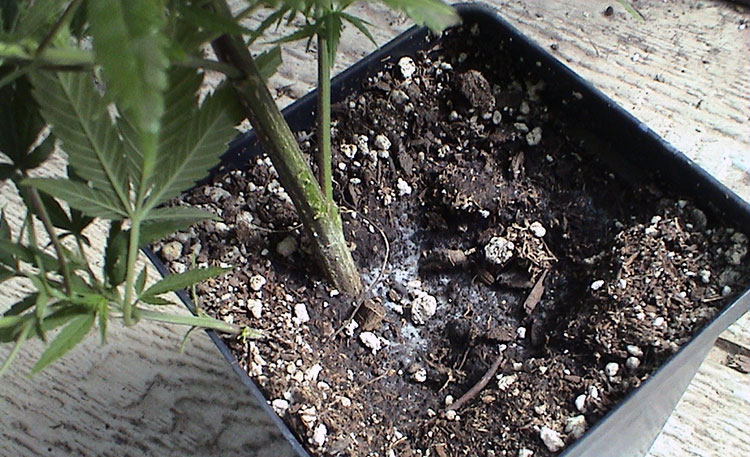
When to inoculate:
- Transplanting: Inoculum is best to apply when transplanting crops, especially in areas where any disturbances have reduced native mycorrhizal fungi.
- Seedlings: Inoculum may be used to produce pre-colonized seedlings that can take advantage of mycorrhizae’s benefits immediately.
- Established plants/trees: Any previous fungicide use or other soil degradation may require inoculation to reintroduce AM fungi to the soil microbial ecosystem.
In ideal conditions, viable propagules can colonize roots effectively in 5–16 days, although it may take 4 or more months to encompass a plant’s root system.
How to Make Mycorrhizal Fungi (DIY Method)
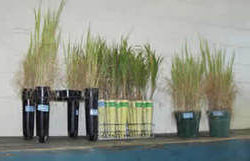
Arbuscular mycorrhizal fungi (AM fungi) are obligate biotrophs, which means that the fungi can only be propagated with a host plant. AM fungi spores can germinate without a host but have a limited capacity to grow and eventually die if they do not encounter a susceptible root for infection.[7]
A suitable host can be any plant variety that supports endomycorrhizal colonization. This includes the 80% of land plants that support AM fungi.
You can use a trap culture method to multiply commercial inoculant (skip forward) or to make your own local AM fungi from a soil sample.
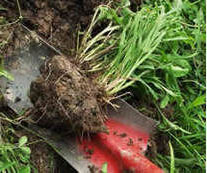
The easiest way to make mycorrhizal inoculant is to get it from a nearby plant. Simply take an infected plant’s root area and place it close to another plant’s roots to inoculate.
Why not stop there?
Direct application of local samples often yields a low (<10%) success rate. That’s why trap cultures are used to multiply the fungi present in the sample. These trap culture methods are widely used and yield a high (>%75) success rate.
Why do trap cultures work so well?
INVAM (International Culture Collection of Vesicular Arbuscular Mycorrhizal Fungi) hypothesizes that:
- Mycorrhizal fungi infectivity appears to be increased in an ever-expanding root space during the active phase of shoot and root growth.
- Once roots have ceased or slowed growth, mycorrhizal colonization slows down accordingly, and at some point, also reaches stasis.
- Carbon (obtained from the plant roots) may be allocated by the fungi differently depending on a plant’s life cycle. The fungi can use carbon to concentrate on external hyphae development (more infective) or sporulation (less infective).
Collecting starter inoculum:

1.) Find a host: To get a locally adapted and taxonomically diverse inoculum, the soil should be collected from a natural area such as a field or forest containing AM fungal plants (see chart). Slightly dry soil works best. To avoid introducing pathogens and obtain a diverse sample of AM fungi, collect samples from a natural, undisturbed location that hasn’t been used to grow the crop you want to inoculate.
2.) Dig it up: Since mycorrhizal fungi can be distributed irregularly, digging up four to five samples is recommended. Most mycorrhizae are found in the top 3 inches of soil, so samples do not need to include soil deeper than this layer. At least 50% roots-to-soil should make up the sample volume for best results
3.) Break it up: Shake off the root balls into a bucket or bin to expose the roots. This contains mycorrhizal spores and hyphae. *Avoid excessive force and/or washing the roots (valuable hyphae will be lost or killed).
4.) Cut it up: Cut the root system into 1–3 cm pieces with scissors and mix into the inoculum. These roots contain mycorrhizal vesicles. With stony soil, sieve it to get rid of large stones.
What’s next? Send it to the trap. The inoculum is now ready to be used in a trap culture.
The Catch-22 is whether to sterilize the starter inoculum or not. While sterilizing will kill any potential unwanted pathogens, it will also kill the viable hyphae present in the inoculum, making it less infective. Sterilization is done by heating the sample in an autoclave, an oven, or by ‘cooking’ in the hot sun.
Making A Trap Culture
AM fungi multiply rapidly on the carbon-rich roots of a fast-growing plant. That’s why a quick-growing C4 variety of grass (warm weather grass) is sown crowded in pots as fungal host plants.
The following method is based on INVAM’s method and Rodale Institue’s On-Farm System:
What you need:
- Starter inoculum
- Bahiagrass seed like this on Amazon
- 15-cm sized pots like these on Amazon
- Coarse silica sand such as swimming pool filter sand like this on Amazon (not crushed coral sand)
Set-up:

- Starter inoculum is mixed with sterilized coarse sand at a 1:1 volume. The mix is then placed in a 15-cm pot. Alternatively, commercial inoculant can be used at the manufacturer’s suggested application rates in a 1:4 compost to vermiculite mix as the Rodale method does.
- Pots are overseeded (80–100 seeds per pot) with Bahiagrass seed. Other plant species can be used, but avoid sparsely rooted and slow-growing plants.
- Pots are placed in a greenhouse or covered table outdoors. Water as necessary. Fertilization is kept to a minimum, being applied only when plants show signs of phosphorus deficiencies (purpling of leaf sheaths) or nitrogen deficiency (chlorosis of young leaves).
- Trap cultures are grown for 4 months.
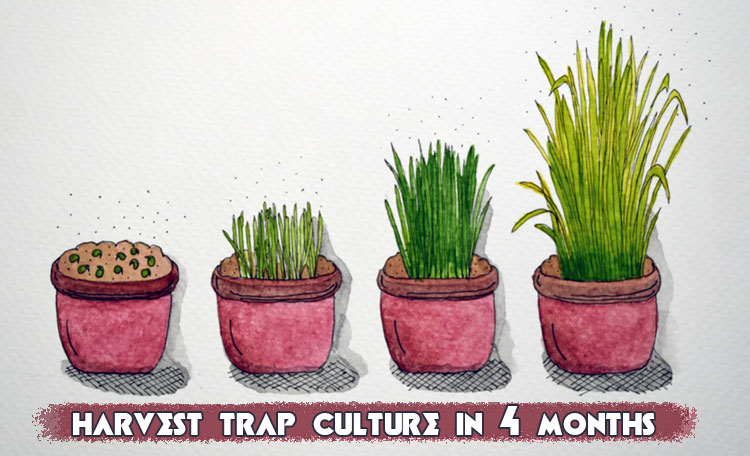
Harvesting trap culture:
At 4 months of growth, trap cultures (roots and medium) are ready to be harvested (shaken and cut up) and applied to plant roots as needed.
Why the wait?
While sporulation does happen in the first three months, INVAM found that during the fourth month is when plant shoots and roots have ceased growth, and carbon seems to be repartitioned to sporulation rather than mycorrhizal development. A longer time is often undesirable because other fungi often colonize the cultures, leading to hyperparasitism.
Use it fresh or store it?
Inoculum is at its highest infectivity fresh due to hyphae’s short life, so it’s best for crop growers to apply immediately.
You don’t need to use all the inoculum at once. You can a) transplant host plants to larger container sizes, b) cut the host plants and reseed the pot, or c) dry the inoculant and place it in bags, storing it in a dark, cool, dry area.
Storing inoculum by drying is mostly for spore extraction and single species research. However, some sources have shown that certain species of AM fungi spores benefit from a dormancy period. You can dry the mix and keep it in bags or containers placed in a low-humidity dark location.
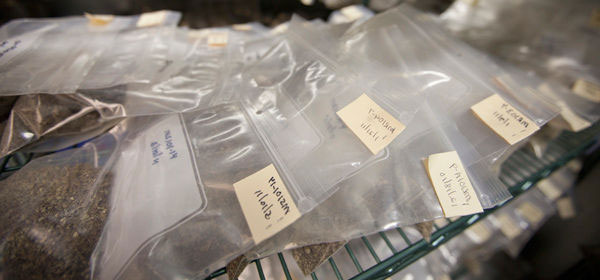
How to apply:
Inoculant should be placed in proximity to plant roots to ensure colonization. If growing under the sun, protect inoculant from direct sunlight by adding mulch or burying it.
- In the ground: Work inoculant into the soil (3 in. max) as close as possible to seedlings, transplants, or established plant roots.
- In pots: Inoculant should be placed directly surrounding transplanted roots (more effective) or mixed evenly into the potting mix (less effective).
Alternatively, the inoculum can be made into a liquid that can be watered into the soil or used as a root dip when transplanting. Use immediately to preserve the max. amount of viable hyphae. (Don’t mix in compost tea. Why?)
- In ground/pots: Water in slowly to ensure root ball penetration.
- In hydro/aeroponics: Dip roots in the liquid instead of running it through irrigation systems, which will damage the delicate hyphae. If you must run it through, filter the liquid (using a paint filter like this on Amazon) to avoid clogging.
How much inoculant do I need?
The On-Farm system recommends a 1:9 dilution ratio of inoculum to medium for starter tray cells that are 50 cm3 (3 cubic inches) or smaller, while larger containers and established plants can use a 1:19 volume.
However, it can be beneficial to use a little more inoculant than is necessary due to the difficulty of obtaining an evenly populated mix.
In theory, only a small amount of inoculant is needed to start the colonization process, as we’ve seen plants get colonized with mycorrhizal fungi in as little as 3 months from a single (injected) spore.[8]
How do I test how much mycorrhizal fungi are present?
Soil samples can be lab tested to find the number of mycorrhizal fungi present. Here are a few labs that provide that service:
Advanced techniques
Wet-sieving and decanting methods can isolate mycorrhizal fungi spores. A bit time-consuming but fairly low-tech and highly effective.
Sucrose density gradient centrifugation, the new plate counting method, adhesion flotation technique, and the capillary rise method also are used for isolating spores. (more).
In vitro growth of AM, fungi are limited due to the fungi requiring a living host to complete its life cycle. Germinating spores in axenic conditions produces swellings that do not appear to develop into spores; however, methods are being used to manipulate spores in these conditions. (more info here)
Mycorrhizal Fungi Inoculant For Sale:
For some plant cultivators, using commercial inoculum may be an easier option to bolster AM fungi populations.
What is it?
Commercial mycorrhizal fungi inoculant is made of freeze-dried fungal propagules that come mixed into clay granules, as soluble powder, or in liquid formulations.
Granular AM Fungi Inoculant
- Glomus intraradices: 104 propagules/gram
- Glomus claroidium: 9 propagules/gram
- Glomus deserticola: 9 propagules/gram
- Glomus mosseae: 9 propagules/gram
- Glomus etunicatum: 9 propagules/gram
- Gigaspora albida: 9 propagules/gram
- Glomus clarum: 9 propagules/gram
Single Species Granular Inoculant
Mykos contains one species of mycorrhizal fungi, Glomus intraradices, known to facilitate nutrient uptake in plants.
Endomycorhizae:
- Glomus intraradices: 80 spores/gram
Soluble Powder Inoculant
Big Foot is a water-soluble powdered blend of 4 AM fungi species plus biochar, kelp, worm castings, and humic acid.
Endomycorhizae:
- Glomus aggregatum: 20 propagules/gram
- Glomus etunicatum: 20 propagules/gram
- Glomus intraradices: 20 propagules/gram
- Glomus mosseae: 20 propagules/gram
Liquid Inoculant
Myco Bliss is a liquid formulation that contains 5 AM fungal species—treats up to 300 plants.
Active Ingredients:
- Glomus intraradices: 100 propagules/ml
- Glomus aggregatum: 100 propagules/ml
- Glomus proliferum: 100 propagules/ml
- Glomus clarus: 100 propagules/ml
- Claroideoglomus etunicatum: 100 propagules/ml
How to apply commercial inoculant:
Inoculant can be applied to roots by:
- Sprinkling onto roots when plants are transplanted
- Watering in via existing irrigation systems or with a watering can
- Worked into seed beds prior to seeds germinating
- Applied to seeds either as a liquid slurry or as a dry coating
- Added into potting soil
- Applied as a root dip gel
- Probed into the root zone of existing plants and trees
What’s good about it?
Commercial inoculant is easy to obtain and apply instantly. For growers who only need to inoculate a few plants, buying it’s a lot more simple than making it yourself.
The infectivity of different mycorhizal inoculants for sale (spores’ ability to colonize on roots) has been tested in various studies, some showing good results while others showing poor results.
Criticism
There are no industry standards for mycorrhizal products, making it hard to know how effective these products may be.
Propagule count vs. Spore count:
More than half of the inoculum could already be expired with propagule-count-based inoculum or have lost a portion of its viability due to the hyphae’s short life. Spores typically only make up about 1/3 of commercial propagules.[4]
Spore count can give a more accurate representation of how much viable product is inside the package, as spores have a multiple-year shelf life when dried out.
Low-Strength Cocktails:
A suspicious industry trend is to cut AM fungi (endomycorrhizal) propagules with cheaper ectomycorrhizal propagules to reduce production costs. Ectomycorrhizae propagules are useless for crop growers. The plant species that associate with endomycorrhizae do not associate with ectomycorrhizae and vice-versa.
Trichoderma?
Certain myco blends contain extremely high proportions of Trichoderma spores, which are cheap to produce but have evidence of interfering with AM fungi during early colonization.[9]
Non-localized species:
Key Points: Commercial inoculants are a quick, simple, and sterile way to inoculate mycorrhizal fungi, although it’s uncertain how effective these products may be.

What Conditions Does Mycorrhizal Fungi Need To Survive?
Soil temperature (not to be confused with air temperature):
🌡️ The optimal soil temperature for mycorrhizal fungi is between 10°C to 30°C (50°F to 86°F). There is a general increase in mycorrhizal colonization within this temperature range.
Too high (above 35°C) or too low (below 8°C) temperatures will slow or halt AM fungi. However, there has been anecdotal evidence of root colonization of AM fungi at soil temperatures as low as 5°C (41°F).[18]
❄️Mycorrhizal fungi survive in cold winters contained within the root tissue of the host plant in vesicles. In the spring, the fungus is capable of regrowth from vesicles in dead root particles.
- Vesicles are spore-like, globular organs that contain energy reserves produced by most AM fungi (this is the benefit of using mycorrhizal roots as inoculant).
Medium:
Aeration is important to producing mycorrhiza.
Perlite, vermiculite, and peat-based potting media with added compost are all shown to be successful in producing concentrations of AM fungus propagules. However, vermiculite was shown to be a higher yielder than the others. [19]
Silica sand (not coral sand) is the most common substrate used for breeding mycorrhizal fungi. This is because of sand’s density—it sinks in water, making spore collection easier.
Water:
💧When mixing an inoculant with water, it’s important to avoid chlorinated water as it may kill mycorrhizal fungi spores. It’s best to use filtered water, rainwater, distilled water, or Chloramine neutralizer in tap water.
pH:
Mycorrhizal fungi occur routinely within a pH range of 4.5–8.0.
It is known that soil factors such as pH restrict the distribution of some taxa.
However, pH is not usually the determining factor regarding mycorrhizal inoculum success. While it can play a part in plant growth and establishment, both plants and their fungal partners can actively adjust this important parameter to benefit the host plant and their fungal partners.[20]
Can mycorrhizal fungi survive in aeroponic, hydroponic conditions?
Yes! Mycorrhizae is not dependent on soil but rather dependent on roots.
Most AM fungi species are known to need oxygen which is why aeroponic methods are preferred over hydroponics. However, this study successfully colonized hydroponic plants with AM fungi by intermittent aeration of the plant roots (2-hour periods, four times per day), and other research has shown species of AM fungi that can survive completely immersed in water.
How to do it:
Many commercial AMF inocula applications use aeroponic propagation methods, which are ideal for the easy collection of fungal spores and hyphae. Although, not all species of AM fungi can flourish in these conditions. (see https://invam.wvu.edu/methods/cultures/aeroponic-cultures)
Contrary to popular belief, AM fungi (and all endomycorrhizal fungi) do not reproduce in compost piles or compost teas.
- The hot composting process exceeds the temperatures that mycorrhizal fungi can live in—above 95°F (35°C), and the spores remain dormant.
- Compost teas that involve steeping inoculant in highly aerated water for an extended period will damage or kill any viable external hyphae.
- Without a host plant, mycorrhizal fungi are very limited in growth ability.
Compost certainly has its benefits to plant soils, but it must be diluted with other mediums and used with a host plant to support mycorrhizae. Mediums composed of 10–25% compost are suitable for increasing AM fungi populations.[21]
“But I can see fungus growing in my compost pile”
Any fungus found in the absence of a living host plant is highly likely to be a saprophytic, non-mycorrhizal organism.
Foliar feeding:
AM fungi are root-colonizing organisms that thrive underground and away from sunlight. Foliar application by spraying inoculant on plant leaves or the soil’s surface does not put the fungi in close enough contact with the plant roots for fungal survival.[2]
Benefits of Using Mycorrhizal Fungi
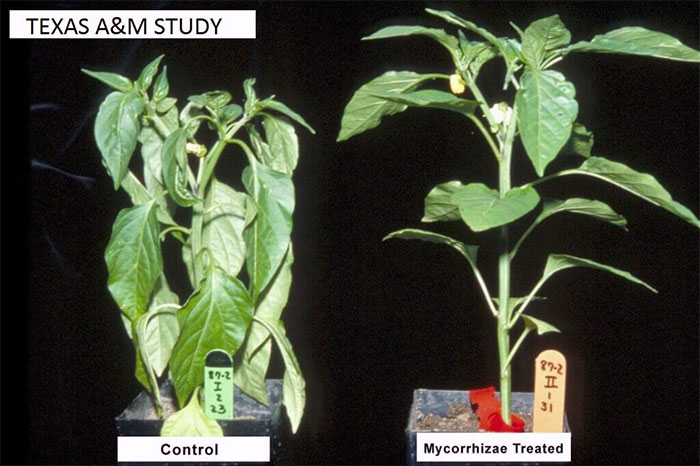
Plants benefit from mycorrhizal fungi in ways such as:
- 🏃Faster growth
- 🚴Faster nutrient cycling
- 🌱Increased root mass
- 🅿️Increased nutrient uptake, especially phosphorus
- ⚖️Increased yields and crop quality
- 🏜️Improved drought resistance
- 🌼Enhanced flowering and fruiting
- 💪Increased tolerance of salinity and heavy metals
- 🎗️Improved disease resistance
While the mycorrhizal relationship is ancient, most scientific research on mycorrhizae has been done in the past few decades.
Regarding cannabis, there’s only one published study on its mycorrhizal relationship, and its focus is on hemp’s metal accumulation abilities. They found that a species of arbuscular mycorrhizal fungi induced growth and enhanced the translocation of metals from root to shoot.
This study found that inoculation with Arbuscular mycorrhizal Fungi Increases the Yield of Potatoes in High P Soil.
This study found that Arbuscular mycorrhizal fungi increased growth, nutrient uptake, and tolerance to salinity in olive trees under nursery conditions.
These results show the mycelium of Arbuscular mycorrhizal fungi increases soil water repellency and is sufficient to maintain water-stable soil aggregates.
More than simply aiding plants in mineral nutrient uptake, Arbuscular Mycorrhizal fungi (AM fungi) have been shown to protect plants from root pathogens by methods such as direct competition for colonization sites, and indirect initiation of plant defensive responses, or altering other rhizosphere biota.[22]
Additional studies are linked throughout this article.
What Does Mycorrhizal Fungi Do for Plants?
Short answer:
- Plant roots give Mycorrhizal fungi sugars and a host (living plant roots)
- Mycorrhizal fungi help plants in nutrient uptake and aid in water and mineral collection.
How it works:
Mycorrhizal fungi use carbon from carbohydrates (sugars) to grow. Plants make these carbohydrates through photosynthesis and excrete them to through their roots to feed the fungi.
In return, plant roots gain the fungus’s increased nutrient absorption abilities—Mycorrhizae mycelium has a higher absorptive capacity for water and mineral elements.
What’s so good about it?
The large surface area of mycorrhizae’s fungal hyphae acts like an extension of the plant’s roots, called extraradical mycelium. Because they are smaller than roots, the microscopic hyphae can penetrate smaller spaces between soil particles.[11]
Mycorrhizal Fungal hyphae also take up and store water to give to plants during dry periods, improving their resistance to drought.[12]
Increased phosphorus uptake
Plants frequently have trouble absorbing the major nutrient phosphorus (P), even when abundant in soil. This is due to P’s low solubility, low mobility, and ability to bind itself with cations, forming insoluble complexes unavailable to plants.
Along with this, plants often develop a phosphate depletion zone around their roots.
Mycorrhizal fungi produce powerful phosphate-solubilizing enzymes that are released into the soil, increasing phosphate solubility. These “digested” phosphate minerals are sent to the host by fungal hyphae transporters, reducing the metabolic energy needed by plants.[13]
This study found that over 50% of P uptake by plants was absorbed via AM fungi, even when P was added to the soil.
Key Points:
Mycorrhizae increase the absorbing area available to the roots and assist plants in water and mineral uptake.
How is Mycorrhizal Fungi Good For Soil?
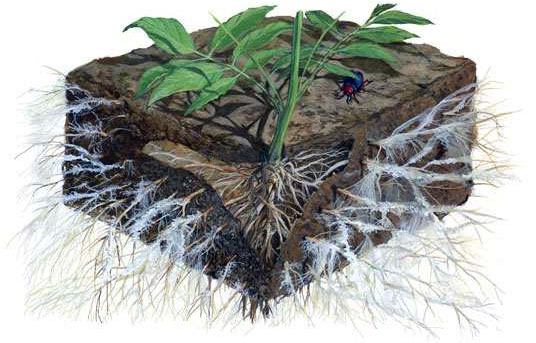
Short answer:
For nutrient cycling; To speed up the decomposition of organic matter in the soil, resulting in more nutrients for plants to use.
Fungi play an important role in the soil food web. The fungal energy channel fuels populations of microarthropods, other mesofauna, and beneficial microbes.
Nutrient cycling
Undecayed matter such as the leaf litter, wood chips, rock powders, and bone meals present in soils all contain nutrients that must be broken down into the smallest particle (ions) to be absorbed by plants.
How do you get that? Decomposition.
While all organic matter is subject to decomposition by microbial (fungi, bacteria) and environmental agents (i.e., rain, wind, sunlight), mycorrhizal fungi help create enzymes that accelerate the decay of this matter.
AM fungi have been shown to accelerate decomposition and acquire nutrients such as phosphorus and nitrogen from organic material.[14]
How it works: Mycorrhizae fungi work as a decaying organisms, mobilizing nutrients to be passed onto the host plant.
A recent study found that mycorrhizae are responsible for 50% of the annual throughput of biomass and 43% of the nitrogen released annually in a Doulis fir ecosystem.[15]
What’s so good about it?
Mycorrhizae fungi can activate immobilized nutrients locked up in long-term nutrient sources present in the soil by decomposition.
Cannabis sativa L. (hemp) plants inoculated with mycorrhizal fungi have been shown to induce growth and absorb more toxic heavy metals from polluted soils.[16]
Mycorrhizae fungi also can act as a pH buffer, allowing plants to receive nutrients such as phosphate ions and iron that they could otherwise not obtain due to pH-related nutrient lockout. This is common in very acidic or fundamental pH soils.[17]
Key points:
Mycorrhizal fungi help create powerful enzymes that unlock immobilized nutrients such as phosphorus, iron, nitrogen, and calcium from material sources in the soil.
How to Increase Mycorrhizal Fungi in 4 Steps
Besides inoculation, here are 4 more tips that will help increase mycorrhizal fungi populations.
Increase Aeration
Mycorrhizae require oxygen to breathe, so aerated soil mixes help increase the number of mycorrhizal fungi that can live and colonize.
Ways to increase aeration in the soil include mixing in non-porous material such as coarse sand, perlite, or lava rock, or mixing in airy porous material such as vermiculite, and rinsed coco coir, or peat moss.
Aeroponics is more successful than hydroponics in harboring mycorrhizal fungi due to the high oxygen level present in aeroponic systems.
Increase Beneficial Bacteria
Mycorrhizal fungi thrive in soils with a high amount of aerobic, beneficial bacteria. There are complex interactions between beneficial soil microbes and mycorrhizae.
As a rule of thumb, anything that will slow down the soil bacteria will, in turn, slow down the mycorrhizal fungi.
Ways to increase beneficial bacteria in the garden include using worm castings, compost teas, and compost.
Apply Mulch
A mulch covering that keeps the topsoil cool and protected from the sun is ideal for cultivating mycorrhizal fungi. Too much heat or UV light can damage the delicate fungi, which is why mulching with organic matter is recommended.
For example, a sub-tropical bean tree Inga (called the ice-cream bean tree), produces leaf litter high in nitrogen. Farmers in Honduras use this tree to grow food crops in a method called “alley cropping“, where crops are grown in between rows of Inga trees. Alley cropping is great for mycorrhizal fungi because it replaces tilling and provides nitrogen-rich mulch for both plants and fungi to benefit.
Avoid Disturbing the Soil
Reducing tillage has been repeatedly shown to increase AM colonization and nutrient uptake. Soil tillage causes severe disruption to the mycorrhizae, resulting in delayed or reduced root colonization and a reduction in soil volume exploited by the AM fungi.
However, the effects on growth and nutrient uptake are in some cases only temporary, which is why it still may be beneficial for growers to occasionally till or disrupt soil if needed and re-inoculate.[23]
What Mycorrhizal Fungi Doesn’t Like:
Fungicides or fumigation will eliminate mycorrhizal fungi in the soil.
Benomyl and thiophanate-methyl are used to suppress/eradicate AM fungi from soil and plants.[24]
Compaction, high NPK fertilizers, hydrogen peroxide, and Epsom salt, are all harmful to AM fungi.
Excessive phosphorus in soil is detrimental to mycorrhizal fungi. You’ll get the most benefits from AM fungi if phosphorus levels are below 70 ppm.
References:
- https://www.ncbi.nlm.nih.gov/pmc/articles/PMC3817225/
- https://www.uaf.edu/files/ces/publications-db/catalog/anr/HGA-00026.pdf
- https://link.springer.com/chapter/10.1007%2F978-3-540-38364-2_5
- https://www.linkedin.com/pulse/quantifying-mycorrhizae-spores-vs-propagules-why-mike-mason-jd-mba
- https://naldc.nal.usda.gov/download/30584/PDF
- https://www.tandfonline.com/doi/abs/10.1080/01448765.2003.9755251
- https://mycorrhizas.info/vam.html
- https://onlinelibrary.wiley.com/doi/abs/10.1002/jpln.200625159
- http://www.scielo.org.co/scielo.php?pid=S0120-548X2006000100004&script=sci_arttext
- https://www.uaf.edu/files/ces/publications-db/catalog/anr/HGA-00026.pdf
- https://www.researchgate.net/publication/228508624_Effects_of_VAM_on_host_plant_in_the_condition_of_drought_stress_and_its_mechanisms
- https://www.ncbi.nlm.nih.gov/pmc/articles/PMC3398253/
- http://www.plantphysiol.org/content/156/3/1050
- https://www.ncbi.nlm.nih.gov/pubmed/11565029
- https://deepblue.lib.umich.edu/bitstream/handle/2027.42/65533/j.1469-8137.1980.tb03189.x.pdf?sequence=1&isAllowed=y
- https://www.ncbi.nlm.nih.gov/pubmed/15698640
- https://besjournals.onlinelibrary.wiley.com/doi/full/10.1111/j.1365-2435.2008.01402.x
- https://www.lebanonturf.com/education/effect-of-soil-temperature-on-root-colonization-by-mycorrhizal-fungi
- https://www.ncbi.nlm.nih.gov/pubmed/20031395
- http://www.nrcresearchpress.com/doi/abs/10.1139/x00-090#.WyOiVSAxXIU
- https://www.ncbi.nlm.nih.gov/pmc/articles/PMC4323289/
- https://www.ncbi.nlm.nih.gov/pmc/articles/PMC3001584/
- https://warwick.ac.uk/fac/sci/lifesci/research/soilmicrobialdiversity/mycorrhizaldiversity_/gosling_et_al_aee_2006.pdf#Rbib73
- https://www.ncbi.nlm.nih.gov/pubmed/18833748
Trap culture images used courtesy of INVAM

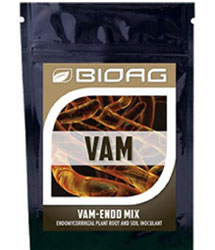
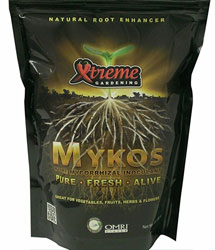
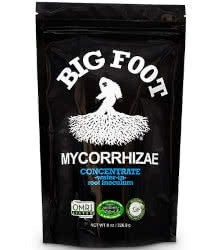
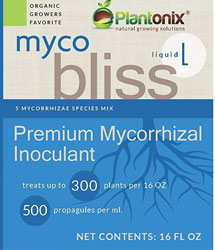
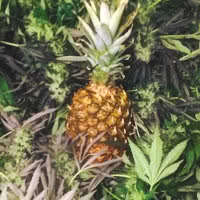
I’ve done my fair share of research over the past year on propogating and cultivating mycorrhizae and I have to say you did an outstanding job writing this article. You’ve basically placed everything into a well written, concise, easy to understand format. Well done!
Thanks Bluto I really appreciate that 🙂
Regarding comments by Bluto: I could not agree more. Outstanding composition
Thanks Leslie cheers 🙂
is there any fungicide that doesn’t harm this type of fungi ?
Hi,
there seems to be a conflicting statement regarding the endo/ecto penetration in the text vs. the pic.
The text says:
Ectomycorrhiazae penetrate the cells of the plant root
Endomycorrhizae do not penetrate cells of the plant root
… while the pic shows the exact opposite.
Thanks for catching that and pointing it out to me Robert, I just updated the article with the changes. Aloha.
Howzit just was wondering out of those commercial products you showed, what is the best one to use.
Aye we like BioAg VAM Endo Mix, apply it directly to the roots during transplant for best results.
Hi. Thanks for the article. Where do your numbers come from? “For a few dollars you can make $40,000 worth (100 million propagules) of mycorrhizal fungi inoculant”
My guess is, if it costs ~$674 for one application of quality mycorrhizae (MycoGrow) for 1 acre, it would cost $40,000 for one application on 59 acres. And I’ve seen recommendations to apply it every few weeks during the growing season if your soil starts off totally dead.
So, if you could buy a smaller amount, and then start a batch every couple weeks, and keep it up, I guess you could save that amount, but over a long timeframe?
Hi. Where is the reference chart for the am fungal plants?
Regarding storage of the inoculum, “dry the inoculant and place it in bags, storing it in a dark, cool, dry area.”
What’s the best way to dry it? Not in sun, I assume, and not at a higher temp than 86 degrees F?
How about a dehydrator on its lowest setting (sadly, 90 or 95 degrees F)?
Or just on trays in a warm-ish, dry room or area?
Thanks. MAN this is an excellent article!!
Awesome guide, thank you so much
Very interesting and informative! Thank you for posting this article.
Thank-You…..excellent read.
This is the updated link for INVAM’s method: https://invam.wvu.edu/methods/culture-methods/trap-culture
Sweet, sweet a** read
Thanks for the knowledge, absolute adding some am fung to the ocean foxfarm this may, cheers
hi, I would like to buy Single Species endo mycorrhizae, can you recommend to me
excellent info and nice science. please identify if cows-milk solutions used as topical myco-control spray for mildew control on vegetation is destructive to subsurface AM and if so- is there a method to have the milk be effective at vegetative mildew control but not harmful to AM> ( possible sterilization of the milk, soil additives, specific nutritive remediation, shielding,shedding at soil surface, etc.)